With the rise of e-commerce and the growing demand for fast and efficient delivery solutions, the requirement for modern courier services has become more important than ever. This is where an app for courier development is a key factor.
The courier industry has seen major changes over the past few decades, from traditional post offices to modern, technologically driven delivery networks. There is no longer a time when sending and receiving parcels required lengthy wait periods and anxiety. Today, customers demand speedy and reliable delivery services that cater to their various requirements.
The courier industry encompasses numerous businesses, including courier companies' logistic providers, logistics firms, and online shopping platforms. Couriers rely on a reliable communication system, a robust infrastructure, and efficient processes to ensure prompt delivery and customer satisfaction.
Importance of Courier Apps in Modern Times
In this digital age, smartphones have become a fundamental part of our lives, changing the way we live and transforming many sectors, including courier services. Apps for couriers provide a convenient and user-friendly service for the service provider and customers to handle the entire delivery process seamlessly.
These applications provide customers with an easy method to make orders, track deliveries in real-time, and connect with delivery staff. They also provide features like updates on delivery status, package tracking, and secure payment options, which enhance the overall experience for customers.
On the other hand, courier apps provide delivery drivers and logistic teams with tools to aid in routing optimization, order management, and performance monitoring. These applications streamline operations, making it easier to reduce errors caused by manual processes and increase efficiency, resulting in cost savings and improved efficiency.
In the ever-changing world of commerce and technology, courier delivery app development has been a fascinating journey that has been able to adapt to evolving consumer demands, technological advancements, and market trends. In this article, we will explore the background of courier apps, their evolution and developments over time, and the prevailing trends that will shape the development of courier apps by 2024.
Historical Perspective on Courier Apps
The idea of courier services is not new, and has roots in the past. Mailers and couriers serve to send parcels and messages over large distances. It was not until the advent of advanced communication and transportation technology that courier services started to develop into the well-organized and efficient systems we have now.
The advent of telegraph and phone services during the 18th century transformed communication and provided rapid and reliable ways for transmitting information. This was the basis for the creation of courier firms and delivery networks that initially depended on manual processes as well as paper-based tracking systems.
The advent of internet commerce in the latter part of the 20th century led to more changes to the world of couriers, when e-commerce began to emerge as the dominant factor in the retail industry. Customers began demanding speedier delivery timings, real time tracking and more transparency when it comes to delivery. In response, courier firms began to adopt digital technology to streamline their operations and enhance customer service.
Changes and Advancements Over Time
The 2000s were the time for the debut of the first generation of courier applications, which were primarily focused on offering simple tracking of deliveries and status reports for customers. They were typically constructed on basic mobile platforms that offered little functionality in comparison to the latest technology.
When smartphones were becoming widespread and mobile technology improved the courier applications underwent major changes that made them more advanced and packed with features. Some of the major advancements that occurred during this time included GPS tracking and scanners for barcodes and electronic signatures as well as secure integration of payments which increased the reliability and efficiency of courier services.
The rise of apps for delivery on demand revolutionized the industry of couriers by allowing clients to request pickups and deliveries with just a couple of clicks on their phones. Companies such as Uber, Amazon, and DHL were the first to take advantage of this trend by introducing new features like rapid pricing changes, immediate notifications as well as crowdsourced networks for delivery.
Current Trends in Courier App Development
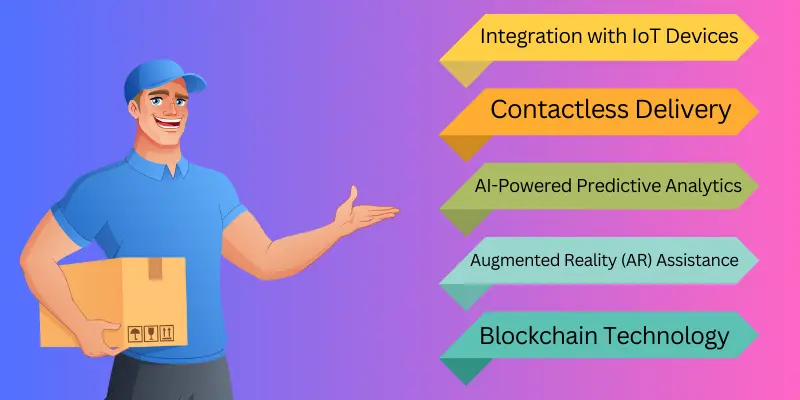
In 2024, the courier app development is marked by several important trends that will shape how the industry will develop in the coming years.
Integration with IoT Devices
Apps for couriers are increasingly using Internet of Things (IoT) technology to monitor packages in real-time as well as monitor the environmental conditions that are in the delivery process, and improve delivery routes according to weather and traffic information.
Contactless Delivery
To combat the COVID-19 epidemic, the use of contactless deliveries has now become an accepted procedure in the world of couriers, with apps that offer doorstep delivery, signatures that are not contact-based and electronic confirmation of delivery.
AI-Powered Predictive Analytics
Artificial Intelligence (AI) as well as machine-learning algorithms are employed to analyze historical data to better predict delivery times and improve logistics for courier companies.
Augmented Reality (AR) Assistance
Certain courier apps are experimenting with the possibility of using augmented reality to offer visual instructions for the pickup and delivery, enhancing efficiency while reducing mistakes for both the drivers and the recipients.
Blockchain Technology
Blockchain is being investigated as a way to improve efficiency and security in the industry of couriers and allowing tamper-proof tracking for parcels as well as secure peer-to-peer transactions.
User Interface (UI) and User Experience (UX) Design of the Application
Users Interface (UI) as well as User Interface (UI) as well as Experience (UX) style play an integral role in the performance of courier applications. In this article we'll discuss the significance of intuitive designs for apps that deliver, the most important UX/UI factors, and the most effective methods to increase the user experience.
Importance of Intuitive Design for Courier Apps
In the crowded market that is couriers, customer experience offered by a service like a courier can determine its performance. An app that is well-designed and has an intuitive interface will streamline the delivery process, enhance customer satisfaction, and distinguish the courier business from its rivals.
A user-friendly interface is crucial for courier apps since it helps users navigate the app with ease and carry out tasks with little effort. From ordering and tracking deliveries to calling customer support and providing feedback, all interactions must be simple and easy to understand.
A user-friendly interface does more than enhance the user experience, but also lowers any learning time for users who are new, improving their adoption rate and retention. Through the design process that is designed to be easy to operate and clear, courier apps are able to cater to a variety of users, such as those who have limited technical skills or impairments.
Key UI/UX Considerations
When creating a courier application certain UI/UX aspects are to be considered to ensure a smooth and enjoyable user experience.
-
-
Clear Navigation: The application should be logical and clear in its layout, and simple menus and buttons for everyday tasks like making orders, tracking shipment and calling support.
-
Consistent Branding: The design of the app should be consistent with the courier's branding guidelines, which include colors fonts, logos, and colors in order to create a coherent and easily identifiable branding identity.
-
Responsive Layout: The app must be able to adapt and responsive to various screen sizes and types, which will ensure an identical experience across tablets, smartphones and desktops.
-
Visual Hierarchy: Visual Hierarchy: Make use of visual hierarchy to highlight crucial information and actions, while directing the user's attention towards crucial elements like delivery status updates, and buttons for calling-to-action.
-
Simple Design: Eliminate clutter and unneeded elements that could make users feel overwhelmed and distract from the application's primary functions. Keep the interface clear and minimal, focusing on the things that matter most to users.
-
Feedback and Error handling: Give explicit feedback to users whenever actions are successfully completed or when mistakes occur. Utilize descriptive error messages as well as helpful tooltips that guide users through the application.
-
Accessibility: Make sure that the application is accessible to people who are disabled by following accessibility guidelines and including features like support for screen readers as well as text resizing and the ability to adjust the color contrast.
-
Best Practices for Enhancing User Engagement
In addition to a simple design and a user-friendly interface there are a variety of best practices that can increase the user's engagement and retention for courier applications:
-
-
Personalization: Enhance your user experience with specific recommendations, targeted promotions and targeted messages based on preferences of the user and their past behaviour.
-
Gamification: Integrate gamification components such as progress bars badges and rewards in order to encourage users to finish tasks or use the app, and reach certain milestones.
-
Social Integration: allow customers to post their experiences with delivery through social media sites as well as connect with family and friends to order together as well as earn points for sharing and referring friends.
-
Community Building: Build an atmosphere of community among users through facilitating peer-to-peer communications forums, user-generated content, and community events. It is encouraged for users to discuss their tips or advice and also feedback among themselves.
-
Feedback Mechanisms solicit feedback from users via surveys, ratings and reviews. Use the feedback to constantly enhance the app's features and capabilities.
-
Core Functionality Features Consideration
In the world of developing apps for couriers certain essential functionality features provide the basis for an efficient and reliable delivery service. In this article we'll examine three crucial elements that are crucial to any app for couriers such as delivery tracking systems and real-time status updates along with secure payments integration.
Delivery Tracking System
A tracking system for delivery is probably the most essential characteristic in any contemporary courier application. It allows both the sender and recipients to monitor the location and status of their parcels in real time giving them security and transparency during the entire delivery process.
A delivery tracking device usually is based on assigning a unique barcode or tracking number for each parcel. This barcode is then scanned at different points along the delivery route. The information is then sent to the backend system, where it's processed and accessible to customers via the interface of the app.
From the point of view of the sender from the point of view of the sender, tracking a delivery system lets them monitor the status of packages as well as confirm the delivery dates and times, and anticipate delays or problems. For the recipient, it gives an overview of the location of their parcels. This allows them to plan delivery and arrange for it.
Alongside the basic tracking features, some courier applications offer more advanced features like geofencing notifications that notify users when their parcel is in a specific distance from their location, and delivery confirmation alerts, which require the recipient to provide digital signatures or photographs after receiving the parcel.
Overall, a solid service for tracking delivery times is vital to increase transparency, trustworthiness and satisfaction of customers with courier apps.
Real-Time Status Updates
In our fast-paced society Customers want instantaneous and immediate updates regarding the delivery status. Updates on status in real time are an essential feature of courier apps, supplying users with up-to-date information regarding the status of their parcels from collection to delivery.
The real-time status updates are generally displayed in the interface for courier apps which allows users to monitor their current position, estimate arrival time, as well as relevant notifications or updates regarding their deliveries.
These updates are enabled by the use of GPS technology. This permits drivers who deliver parcels to send their location information to the backend system of the courier app in real-time. This information is relayed to the users via the interface of the app, making sure that they're always updated on what's happening with their packages.
In addition to tracking location real-time status updates can include details about delivery attempts, delays, as well as any other important events that might affect the delivery timetable. This lets users be aware and to control their expectations about their delivery schedules.
All in all, real-time status updates are vital to provide customers with current information on their delivery, increasing transparency, as well as enhancing the overall experience for customers.
Secure Payment Integration
In this age of digital transactions and internet commerce secure payment integration is an essential feature of courier applications. Users can pay for their delivery directly from within the app, removing the requirement to use cash or processors.
Secure payment integration usually is the integrating of payment processing services like PayPal, Stripe, or Braintree which allow secure and secure transactions between users as well as courier firms. Users are able to securely input their payment details in the app's interface and payment processing occurs in real-time, providing the most seamless and user-friendly payment experience.
Alongside facilitating payments for delivery services Secure payment integration can be accompanied by features like payment schedulers as well as recurring payments and the management of invoices, which allows users to manage their payments and keep track of their transactions history in the application.
From the viewpoint of courier businesses Secure payment integration can provide many benefits, such as faster processing of payments, less dependence on cash transactions and enhanced the management of money flow. It also aids in building confidence and trust with customers through providing safe and secure payment services.
Advanced Features for Efficiency of the Courier Delivery Application
In today's fast-paced industry of delivery services, efficiency has become a must. To stay ahead of competitors and keep up with the increasing needs of their customers the courier applications are adding advanced features that make use of modern technology. In this article we'll examine three of the most technological advancements that improve effectiveness: route optimization algorithms as well as automatic scheduling and dispersing along with integrations to Internet of Things (IoT) devices to track package delivery.
Route Optimization Algorithms
Route optimization algorithms can be a useful tool to improve effectiveness of delivery services, by reducing the time required to travel, the fuel consumed as well as wear and wear and. The algorithms evaluate various aspects including the location of delivery along with traffic conditions and delivery timeframes to identify optimal routes to deliver drivers.
By optimizing delivery routes, courier applications can cut delivery times, increase the amount of delivery per driver and reduce operating expenses. This does not just improve the effectiveness of delivery but also increases customer satisfaction by ensuring prompt delivery.
Routing optimization algorithms usually operate by creating optimized delivery routes using factors such as the delivery location, vehicle capacity and time limitations. These routes are then presented to drivers through the interface for courier apps as well as directions for navigation by turn and estimated time of arrival.
Apart from optimizing specific delivery routes some courier apps provide features for optimizing fleets that optimize scheduling and routing of multiple vehicles to reduce overall delivery time and increase the utilization of resources.
Overall, routing optimization algorithms are a useful feature of courier applications that significantly enhance efficiency, cut costs, and increase customer satisfaction.
Automated Scheduling and Dispatching
Automated dispatching and scheduling is a further modern feature that will improve delivery efficiency and boost efficiency of courier firms. This feature makes it easier to automate the process of assigning delivery duties to drivers based on various factors like availability of drivers and vehicle capacity as well as priority for delivery.
Automating dispatching and scheduling applications for couriers, they can decrease manual labor, eliminate human error, and make sure that deliveries are made efficiently feasible. This helps courier companies maximize their resources and react promptly to the changing demands and delivery demands.
Automated dispatching and scheduling software typically operate by integrating with backend systems like order management systems as well as driver databases, which allow for access to the most current information on availability of drivers as well as vehicle capacity and the delivery requirements. Utilizing this information the system creates optimized delivery schedules, and assigns tasks to drivers accordingly.
Apart from improving efficiency Automated scheduling and dispatching increase customer satisfaction by offering more precise estimates of delivery times and reduce the risk of delayed or missed delivery.
Overall the automated dispatching and scheduling is an effective feature of courier applications that help simplify operations, cut expenses, and increase the quality of service.
Integration with IoT Devices to Track Packages
Integrating with Internet of Things (IoT) devices to track package delivery is a new technology that allows couriers to monitor locations, conditions and status of packages in real time using equipment and sensors.
Through integrating with IoT devices, such as GPS trackers as well as temperature sensors and moisture sensors, courier applications offer customers detailed details about whereabouts and the condition of their parcels during the process of delivery. This increases transparency, lowers the possibility of damage or loss, and enhances the overall customer experience.
IoT devices that track packages provide important information, including live updates of location and temperature readings, as well as alarms for shock detection. The data is sent to the backend system, where it's processed and available to users via the interface for the app.
In addition to enhancing the tracking of packages, integrating with IoT devices also allows preventive maintenance as well as troubleshooting, by alerting couriers to possible issues, like delays, route deviations or environmental dangers.
Overall, the integration of IoT devices to track packages is an innovative technology that could help courier companies gain useful insights, increase the customer experience and differentiate their offerings in the fiercely competitive industry of couriers.
Also Read : Must-Have Features Of Online Courier Delivery App 2024
Customer Engagement and Communication Tools Will Enhance User Engagement
In today's competitive world that is courier service, a strong communication and engagement with customers is essential to build solid relationships, building trust and improving the overall experience for customers. In this article we'll look at three important tools for communication and customer engagement that are crucial to the app's success that send push notifications to customers to update orders as well as chat support within the app as well as feedback and rating systems.
Push Notifications for Order Updates
Push notifications can be a useful method to keep customers informed and involved throughout the entire delivery process. Through the direct delivery of timely notifications to devices of the users courier apps are able to provide instant updates on the progress of their orders. This includes order confirmation, tracking of the shipment delivery reminders, and the delivery's completion.
Push notifications are a proactive channel for communication that allows couriers to relay important information to their customers without having them actively browse the application. This improves visibility and transparency, but can also increase customers' satisfaction as they are kept up-to-date and confident about the status of their delivery.
Alongside order updates and push notifications, they can be used to provide targeted offers, promotions and other updates to customers according to their preferences as well as past behaviour. This allows customers to be engaged and encourage return business by offering timely and relevant incentives that encourage more interaction using the application.
In the end it is clear that push notifications are a vital instrument for customer engagement and communication within courier apps. They provide an efficient and convenient way to keep customers updated and engaged throughout the entire delivery process.
In-App Chat Support
Chat support in-app is another important feature that can increase the customer experience and communication on courier applications. With direct access to support representatives within the app's interface, couriers are able to provide immediate assistance, respond to questions, solve issues, and resolve issues quickly and effectively.
Chat support in the app allows users to interact with support agents in a simple and familiar space and without the need to switch to other channels of communication, such as email or phone calls. This eases the process and enhances the overall experience for customers by offering a seamless and seamlessly integrated support in the application.
Alongside assisting customers with queries and issues, the chat support in-app can also be used to collect feedback, solicit suggestions, and seek input from users to enhance the app and its services offered. This can help to create an atmosphere of community and cooperation between courier companies and customers and can result in increased satisfaction and loyalty of customers.
In the end, chat support in apps can be a useful method to improve customer interaction and communication in courier apps. It offers an efficient and convenient method for customers to communicate with support representatives from customer service and get help whenever they require it.
Feedback and Rating System
Rating and feedback systems are crucial to gather feedback from customers to gauge satisfaction and identify areas of improvements in courier applications. Through soliciting feedback from their clients and permitting those to evaluate their experience with delivery couriers can gain valuable insight into how they can improve their services as well as identify areas for improvement.
Feedback and rating systems usually permit customers to give feedback about different aspects of their experience with delivery such as the speed of delivery as well as the quality of the delivery drivers and the condition of their parcels, and general satisfaction with the delivery service. The feedback is used to assess performance, find patterns, and prioritize improvements.
Apart from giving important feedback to courier firms, Feedback and rating systems empower customers by providing them with an opportunity to speak up and to express their views and experiences. This builds confidence and trust with customers, and also demonstrates the commitment to openness and honesty.
Security and Privacy Measures
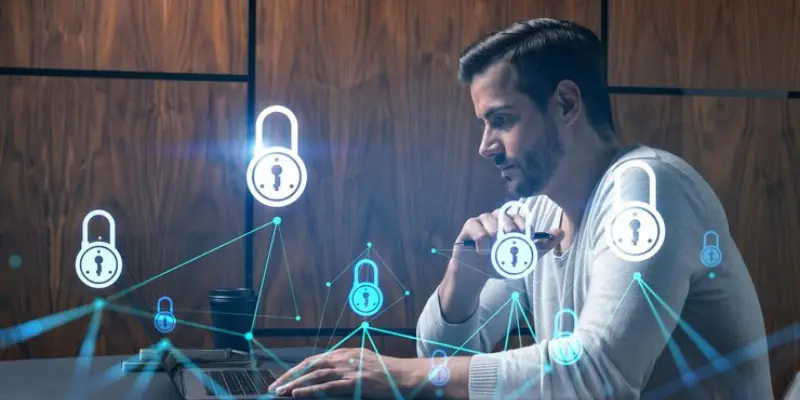
In the age of growing digitization and data breaches privacy and security have become essential concerns for both companies as well as consumers. Apps for couriers, which handle sensitive financial and personal information should implement strong security measures to guard personal data of users and guarantee the security and integrity for their products. In this article we'll look at three important protections for privacy and security crucial for courier applications such as encryption of data as well as secure login and security as well as the compliance with regulations regarding data protection.
Data Encryption Techniques
Data encryption is an essential security measure to protect sensitive data from unauthorised access or intercept. For courier applications, data encryption techniques are employed to secure data during transit and in rest, making sure that it is secure and secure throughout its lifetime.
The encryption process transforms plaintext data into ciphertext by using mathematical algorithms as well as cryptographic keys. The encrypted data cannot be decrypted or read by authorized individuals who have the encryption key, which makes it impossible for unauthorized individuals to gain access to or read encryption data.
In courier apps, sensitive data such as user credentials, payment information, and shipment details are encrypted using strong encryption algorithms such as AES (Advanced Encryption Standard) or RSA (Rivest-Shamir-Adleman). This is a way to safeguard the privacy of users and prevent unauthorized access to sensitive information even in the case of a data breach or security event.
Additionally, in addition to encryption of information that travels over the internet, these apps also secure data in databases or servers. This guarantees that, even if a hacker gains access to the infrastructure, they are incapable of accessing or extracting sensitive data without having the right encryption keys.
In the end, encryption of data is an essential security measure to safeguard sensitive information within courier applications, ensuring the privacy of users, while ensuring the confidentiality and integrity that the app provides.
Secure Login and Authentication
Login and security systems are vital for confirming identities of the users as well as stopping unauthorised access to courier applications. These methods help to ensure that only authorized users with valid credentials are able to access the application along with its capabilities, thus reducing the possibility of unauthorized access and data leaks.
Courier apps generally use secure authentication methods, such as username/password authentication, biometric verification (e.g. face or fingerprint recognition) as well as 2-factor authentication (2FA) to confirm the identity of the users when they log in.
The most commonly used method of authentication employed in courier applications, which requires users to use a specific username/password combination in order to gain access to their account. To increase the security of users, they are advised to use strong, complicated passwords, and are advised to change their passwords frequently to limit the possibility of password-based attacks, such as dictionary or brute force attacks.
Biometric authentication is yet another secure method of login that utilizes specific physical traits like the fingerprints of a person or features on their face to confirm the authenticity of the user. This offers an additional security layer and ease of use because users can authenticate themselves by using biometric information that is stored in their device, without having to memorize complicated passwords.
Two-factor authentication (2FA) provides an additional security measure by requiring users to provide two types of identification prior to granting the access they need to account. It typically requires two things: something that the user is familiar with (e.g. the password) and a document the user owns (e.g. a one-time passcode that they have sent through their smartphone).
All in all security, safe login and security methods are vital to protect accounts of users and stopping unauthorised access to courier applications and ensuring that sensitive data is kept safe and secure.
Conformity in Data Protection Regulations
Alongside implementing technological security measures, courier applications must also adhere to the regulations governing data protection and standards to ensure privacy of the user and to ensure compliance with the law. These laws govern how companies gather, store, process and protect personal data. Failure to adhere could result in severe fines and reputational harm.
The most widely-known laws governing data protection can be found in that of the General Data Protection Regulation (GDPR) that applies to companies that handle personal data of people within the European Union (EU). The GDPR sets strict standards for data processors and controllers with regard to the minimization of data, purpose restriction, accuracy of data, as well as data protection.
In addition to GDPR, courier applications may have to be compliant with different data protection laws and standards, based on their area and what they do for work. For instance, in the United States, courier apps might be required to adhere to laws like those under the California Consumer Privacy Act (CCPA) or the Health Insurance Portability and Accountability Act (HIPAA) when they deal with sensitive health or personal data.
To ensure compliance with the regulations regarding data protection To ensure compliance with data protection regulations, courier applications must employ suitable data protection measures, like encryption of data as well as control of access, anonymization as well as periodic security audits as well as tests. Users must also be provided with control and transparency over their personal data and allow them to access and correct or erase their personal data on the request of users.
In the end, compliance with the regulations on data protection is crucial to maintain confidence and trust when using courier services, showing an interest in security and privacy while avoiding legal and regulatory sanctions.
Scalability and Customization Options in the Application
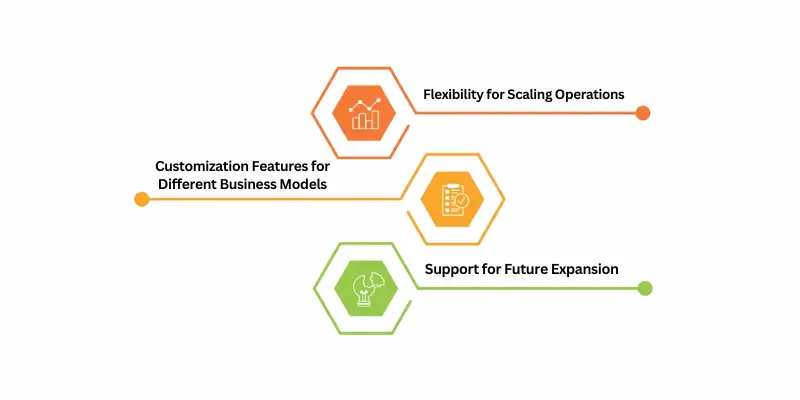
In the constantly changing and evolving world of courier services, scaling and customization are crucial aspects of achieving the success of a courier service. As courier businesses expand and change they require robust solutions that can be able to adapt to evolving requirements and scale operations effectively, and support various business models. In this article we'll look at three important aspects of scalability and customisation for courier apps: the ability to scale operations, custom features that can be adapted to various business models, and the ability to expand in the future.
Flexibility for Scaling Operations
Scalability is the capacity of a system's capacity to cope with an increase in workload and growth without sacrificing quality or reliability. For courier applications the ability to scale is vital to adapt to changes in demand, grow into new markets, and handle increasing volumes of shipments.
To ensure scalability the courier applications must be built using scalable and flexible structures which can adapt to shifts in traffic and workload patterns. This could mean using cloud-based infrastructure or microservices architecture that allows for modular mobile app development and vertical scaling of components on the demand.
Cloud-based infrastructures, such as Amazon Web Services (AWS) or Microsoft Azure offer the ability to scale resources up and down in accordance with changes in demand. This means that courier applications can handle the surge on traffic at peak times like promotions or holidays, without causing performance issues or interruptions in service.
Along with technical scalability and scalability, apps for couriers should additionally be flexible from a commercial standpoint, with the capability to accept new customers, establish new delivery routes as well as expand to new geographical regions with ease. This requires business processes that are scalable as well as efficient resource allocation and strategic alliances with delivery and logistics partners.
In the end, flexibility to scale operations is vital to ensure that courier apps grow and adjust to the changing market conditions and meet the increasing demand and ensure the highest levels of performance and dependability.
Customization Features for Different Business Models
Courier companies are active in a wide range of markets and industries, each with their own distinct business model and requirements. To meet these diverse needs the apps for couriers must provide options for customization that permit users to tailor their application to meet their individual requirements and preferences.
The customization options include customizable options for delivery prices, pricing as well as scheduling rules and branding, which allows couriers to tailor their app to reflect their distinct brand and offerings. For instance the app for couriers used to support a delivery company might require support for different kinds of deliveries including on-demand deliveries or scheduled deliveries. Catering, all having different pricing structures along with delivery services.
Alongside the customization options for companies, courier apps should also provide customization options for customers who want to customize their preferences for delivery as well as track orders and even communicate directly with drivers of delivery in real time. This increases the experience for customers and increases customer satisfaction by offering a customized and personalized customer service.
In the end, features that allow customization to accommodate different business models are crucial to ensuring that courier applications accommodate the different demands of customers and businesses as well as adjust to the changing market conditions and stay an advantage in the marketplace.
Support for Future Expansion
In an industry that is rapidly changing such as courier services, future expansion is inevitable as companies are looking to expand and take advantage of new opportunities. The apps for couriers must be designed with scalability as well as the possibility of future growth in mind, and with the ability to accommodate new features, integrations and capabilities as the industry grows.
To allow for future expansion to accommodate future expansion, courier applications must build on flexible, adaptable structures that can adapt to new technology and requirements. This could mean the adoption of modular development practices, open APIs, open APIs, as well as integration frameworks that permit seamless integration with third party platforms and services.
Alongside technical considerations and future expansion, it is also a matter of strategic planning and foresight with a particular focus on identifying new trends, market opportunities and the needs of customers. Courier companies have to continuously develop and improve their services to stay ahead of competitors and keep up with the changing requirements of customers.
Overall, support for the future expansion is crucial to ensure that courier apps grow and evolve to market conditions, take advantage of new opportunities to remain relevant and competitive in the field.
Integration Capabilities to Third-Party Services
In the world of interconnected courier services seamless integration with third party services is crucial to optimize processes, increasing capabilities, and offering a better customer experience. Apps for couriers must be able to connect with a range of external systems and platforms in order to make use of their capabilities and offer additional value to the users. In this article we'll examine three essential integration capabilities of courier apps that include integration with navigation and mapping APIs as well as integration with payment processors and integration in inventory-management systems.
Integration with Mapping APIs and Navigation APIs
Mapping as well as navigation APIs like Mapbox and Google Maps or Mapbox are vital tools to optimize deliveries, providing precise information about location, as well as enabling turning-by-turn directions for drivers. Integrating these APIs enables courier applications to use advanced routing and mapping functions to enhance efficiency and security when it comes to delivery.
Through integration with the navigation and mapping APIs, courier apps can provide customers with up-to-date information regarding the exact location of the parcels they deliver, estimates for delivery times and the most efficient routes to deliver. This increases transparency and makes it easier for the users and allows them to monitor their deliveries more efficiently and organize their schedules according to their schedules.
Maps and navigation APIs allow courier apps to optimize delivery routes according to factors like road closures, traffic conditions and delivery priority. This allows for a reduction in delivery times, decreases the use of fuel, and increases the overall efficiency of courier firms.
In the end, integration with mapping as well as navigation APIs are crucial to optimize delivery routes, increasing transparency and providing an enhanced experience for customers using courier applications.
Collaboration with payment Gateways
Payment gateways are an additional essential element of courier apps that allow users to make secure and easy payments for delivery service. Integrating payment gateways permits courier apps to provide different payment options, such as credit/debit card transactions along with digital wallets, bank transfers. These apps can make transactions secure and efficient.
Through collaboration together with the payment processors apps for couriers can make payment processing easier as well as reduce the amount of friction users experience and enhance the overall experience of shopping. This can help increase conversion rates, decrease abandonment of carts, and boost sales growth for courier businesses.
In addition to processing transactions and transferring money, payment gateways offer options like the detection of fraud, management of chargebacks and recurring billing. All of these features aid in enhancing security and ensure compliance with the payment industry's standards.
In general the collaboration between payment gateways is crucial to offering a secure and seamless payment experience for customers and increasing business growth for courier applications.
Integrity with Inventory Management Systems
The inventory management system plays an important function in coordinating and monitoring inventory for courier firms and ensuring that the appropriate products are on hand at the correct time and in the proper quantities. The integration with systems for inventory management enables courier applications to share inventory information in real-time and monitor stock levels and better manage orders.
Through integration with systems for managing inventory these apps give customers up-to-date details on availability of products as well as pricing and delivery dates. This improves transparency and trust for customers and allows them to make informed choices and to place orders with confidence.
Integrating with management of inventory systems allows courier applications for automated order handling, decrease mistakes that are made manually, and also optimize levels of inventory based on forecasts of demand and sales data. This improves efficiency in operations, cuts expenses, and reduces inventory shortages and overstocking.
In the end, integration to inventory control systems vital to optimize inventory management, streamlining fulfillment, and ensuring an efficient and seamless user experience courier applications.
Challenges and Solutions in Courier App Development
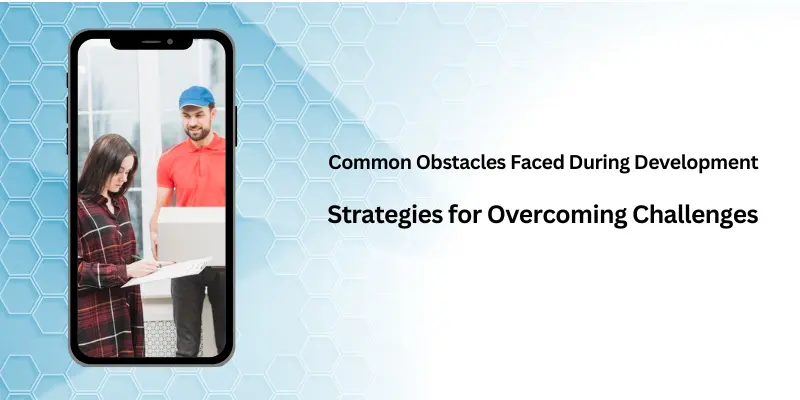
Development of apps for Courier, as every other custom software development project is not without its own set of difficulties. From technical challenges to management concerns, getting through these challenges require careful preparation, innovation and flexibility. In this article we'll look at common challenges encountered during the development of courier apps and the strategies to overcome these difficulties.
Common Obstacles Faced During Development
-
-
Complex Logistics: One of the biggest problems in developing apps for couriers is tackling the complex logistics processes. Managing several delivery options, managing various sizes and weights for packages as well as coordinating with multiple delivery providers can be a challenge and require advanced algorithms and systems to simplify.
-
Real-Time Tracking: Implementing real-time tracking capabilities isn't easy because of the requirement for precise location information easy integration into mapping APIs as well as efficient processing of data in order to give users timely updates.
-
Scalability: When the number of users increases and the number of delivery increase, scalability is an essential issue. Making sure that the application can handle a high volume of traffic to accommodate new users, add features and also scale resources in a dynamic manner is crucial to ensure the performance and reliability.
-
Secure Data: Handling sensitive information about users such as personal details, payment information and delivery addresses needs strict security measures to safeguard against data loss and unauthorised access.
-
UX: Offering an intuitive and seamless user experience across various platforms and devices is a different issue in the development of courier apps. Combining functionality with ease and speed of load, and creating an easy-to-use interface that meets the requirements of both senders as well as recipients is vital to customer retention and adoption.
-
Strategies for Overcoming Challenges
-
-
Modular development: By breaking down the process into smaller, manageable components allows teams to concentrate on specific functions and develop quickly. When adopting an agile approach to development in addition to releasing small updates teams can tackle difficult logistics issues iteratively and respond to evolving requirements more efficiently.
-
Use Advanced Technologies: Leveraging advanced technologies like artificial intelligence, machine learning and predictive analytics could assist in optimizing logistics processes and improve the planning of routes and boost delivery forecasting. These tools can make repetitive work easier, study massive amounts of data, and find patterns and trends that can be used to make data-driven choices.
-
Cloud-Based Solution: Utilizing cloud-based infrastructure and services, you can get flexibility along with reliability, cost-effectiveness, and reliability for the development of courier apps. Cloud platforms provide the flexibility of tools, automated scaling and global availability, which allows applications to manage an increase in traffic and demand without a significant infrastructure investment or performance loss.
-
Security best practices: Implementing secure measures like encryption of data as well as secure authentication and regular security audits will aid in reducing the threat of data breaches as well as protect sensitive user data. The compliance with the industry standards and regulations like PCI-DSS and GDPR ensures that the application adheres to the most stringent privacy and security rules.
-
User-Centered Design: Prioritizing user experience and conducting feedback and testing sessions throughout the process of development can aid in identifying usability issues such as the causes of pain, or areas to improve. By designing with empathy and focusing on accessibility and usability ensures that the app is able to meet the expectations and requirements of its users.
-
Future Trends and Predictions for Courier App Development
The courier industry is evolving in response to evolving consumer preferences, technological advances, as well as market trends, several new trends are influencing the future of mobile application development. Through the integration of modern technology to the adoption of novel business models the future of the business promises thrilling opportunities as well as new challenges. In this article we'll examine the latest developments for developing apps for couriers and provide predictions about what the future holds for the business.
Emerging Technologies in Courier App Development
-
-
Artificial Intelligence (AI) and Machine Learning: AI and machine-learning technologies are revolutionizing on-demand courier delivery app development by allowing intelligent decision-making predictive analytics, as well as the automation of repetitive tasks. AI-powered algorithms can improve delivery routes, anticipate the delivery time, as well as recognize the patterns or trends that are evident in data about delivery to increase the efficiency and accuracy of.
-
Internet of Things (IoT): The Internet of Things (IoT) is revolutionizing the delivery industry through the use of real-time tracking, monitoring, and control of delivery vehicles and parcels. IoT-connected devices like GPS trackers and temperature sensors as well as RFID tags could give valuable insights into data and improve control and visibility all through the process of delivery.
-
Blockchain Technology: Blockchain technology is being studied for its potential to improve transparency as well as traceability and security when developing courier apps. Through the use of blockchain-based platforms couriers can guarantee the accuracy of delivery records, avoid fraud and tampering, as well as facilitate cross-border transactions and payments.
-
Augmented Reality (AR) and Virtual Reality (VR) AR and VR technology are integrated into courier applications to provide interactive and immersive experiences for customers. AR-enabled apps provide visual directions and guidelines to help with delivery and pickup of packages as well as VR simulations that can be utilized to train delivery drivers and improve route planning.
-
Autonomous Vehicles as well as Drones A: emergence of drones and autonomous vehicles transforms last-mile delivery as well as urban logistics. Courier apps are experimenting with the potential of drones with autonomous capabilities and delivery robots to speed up and effective delivery of small packages and parcels in areas with high density of population which will reduce the time of delivery and reduce carbon emissions.
-
Predictions for the Future of the Industry
-
-
Contactless Delivery: COVID-19 has led to a rapid increase in the acceptance of delivery methods that use contactless technology like doorstep delivery and pickup points. In the near future we will likely continue to see an increase in the use of contactless delivery to increase security and reduce human interaction when delivering.
-
On-Demand and Same-Day Delivery Customers' expectations for speedy and efficient delivery options continue to increase which is driving demand for both on-demand and same-day delivery services. The courier apps must prioritize speed as well as reliability and flexibility to satisfy the increasing demands for instant gratification and convenience.
-
A focus On Sustainability as well as Green Logistics: With the growing awareness of environmental and sustainability issues, couriers are being pressured to implement eco-friendly methods and cut down on the carbon footprint they leave behind. In the coming years we will likely witness a more prominent focus on green logistics strategies like bicycle couriers, electric vehicles and environmentally-friendly packaging alternatives.
-
Integration with E-commerce Platforms: as the e-commerce industry continues to expand and develop, courier applications must integrate seamlessly with eCommerce platforms in order to provide seamless delivery and fulfillment of orders. Integration with online platforms like Amazon, Shopify, and eBay will be crucial for increasing market share and satisfying the demands of online buyers.
-
Personalized Delivery Experiences: The apps for couriers are increasingly focusing on offering personalized delivery experiences that are tailored to the specific preferences and demands of customers. From the flexibility of delivery options to customized packaging and delivery guidelines, personalization is crucial in boosting the customer's satisfaction and loyalty in a competitive sector of couriers.
-
The Key Takeaway
The evolution of developing on-demand courier delivery applications is characterized by a constant search for innovation and adapting to new trends. Utilizing cutting-edge technology like AI, IoT, and blockchain to meet the needs of today's consumers, to predicting and preparing for the future of changes in the industry, courier apps are at the forefront of transforming how delivery is delivered.
Looking ahead we see the industry poised for a steady growth rate, driven by the growing use of contactless delivery, the growth of services on demand as well as a growing emphasis on sustainability. By adopting these trends, focusing on the user's experience and encouraging cooperation with e-commerce platforms as well as delivery partners, courier firms are able to position themselves for success in a highly competitive marketplace. The future of application development looks bright and holds amazing opportunities for improvement, efficiency and satisfaction of customers.





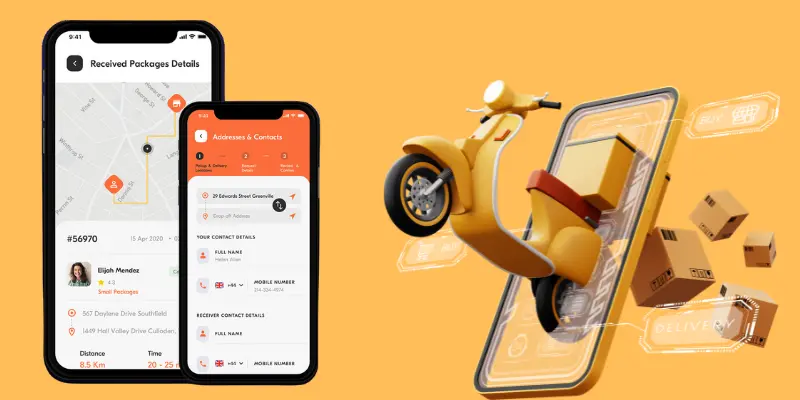


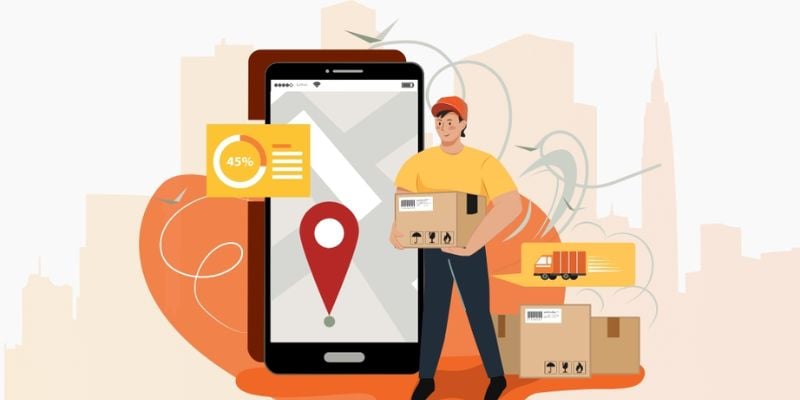
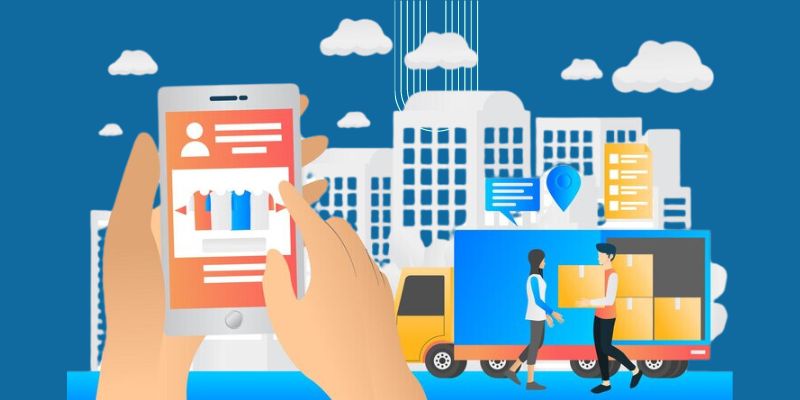



Share this blog